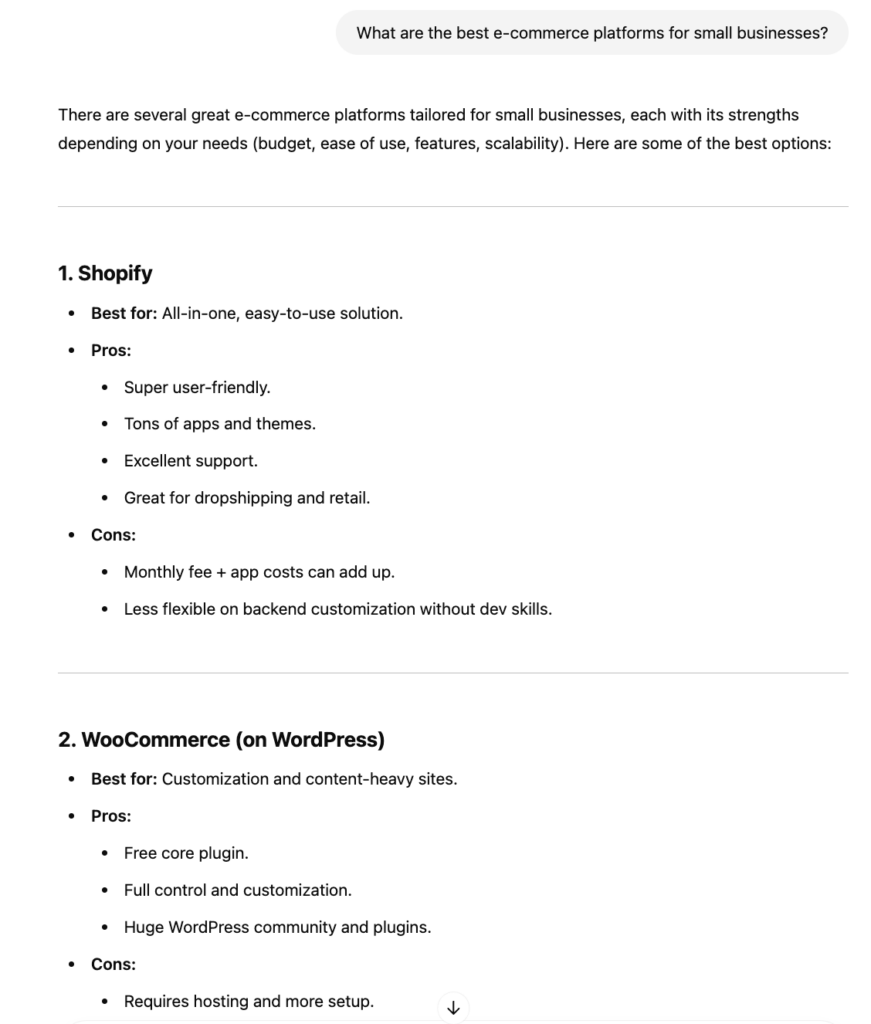Generative Engine Optimization: everything you need to know for 2025
Until recently, "visibility in Google" was synonymous with success in digital marketing. Today, in the era of generative AI, not only tools are changing, but above all, customer touchpoints. The customer journey is shifting -today, it often begins on AI-driven platforms like ChatGPT, Perplexity, Copilot, or Gemini, not Google.

58% of users have already replaced traditional search engines with AI-driven tools for product and service discovery (Capgemini, 2025). 63% of websites report traffic coming from AI search (Ahrefs, 2025). Most importantly, 64% of customers express readiness to purchase products suggested by AI (Master.of.Code, 2024). This isn’t the future – it’s the present
This context introduces GEO – Generative Engine Optimization – a new specialization within the search ecosystem. GEO doesn’t replace traditional SEO but complements it by optimizing content specifically for language models and generative AI responses.
Just as we once competed for positions in Google’s results, today we strive to have our brand cited and recommended by generative models.

What is Generative Engine Optimization (GEO)?
GEO is a new branch in digital marketing aimed at optimizing website content and structure for visibility in AI-driven generative search engines, such as ChatGPT, Perplexity, Copilot, or Gemini.
Unlike traditional SEO, which focuses on SERP rankings and clicks, GEO aims to ensure your brand is referenced, cited, or recommended in AI-generated answers – even if users never click a link.
How does this work in practice?
Consider a user typing into ChatGPT: “What are the best e-commerce platforms for small businesses?”
Instead of providing a list of links, AI generates an answer citing specific brands and sources. If your content is well-optimized (and matches the intent of the query), it might be included as a part of the answer or recommendation – along with a link and brand mention.
This shift is fundamental. GEO isn’t just about rankings – it’s about citations. Being first in search results isn’t as crucial as being included in AI’s answers.

Why does GEO matter in 2025?
GEO isn’t merely a buzzword – it’s a response to evolving search realities:
- Gartner predicts that by 2028, up to 25% of searches will move to generative engines.
- ChatGPT has already surpassed 400 million active weekly users and more than 5.2 billion monthly visits (Exploding Topics).
- Perplexity AI is rapidly growing, with over 50 million monthly visits and over 500 million queries per year (Exploding Topics).
- 63% of websites report traffic originating from AI-based search engines (Ahrefs).
- 58% of users have replaced classic search engines with AI tools when searching for products or services (Capgemini).
Simply put: if your brand isn’t appearing in AI answers, for many users, it doesn’t exist.
SEO vs GEO – similarities, differences, and… a new reality in search
For years, SEO has been the gold standard for increasing online visibility. We optimized content for Google bots, built links, and analyzed keywords. And we still do.
But in 2025, a new force emerged: Generative Engine Optimization (GEO). It doesn’t compete with SEO – it complements it by tailoring content for generative answer engines like ChatGPT, Perplexity, Gemini, or Copilot.
- SEO = Visibility in search engines
- GEO = Presence in AI-generated answers
SEO: Competing for clicks
SEO fights for clicks. It’s all about ranking in Google results, CTR (Click-Through Rate), technical correctness, and keyword semantics. The user must click a link to visit a website.
GEO: Competing for citations
GEO competes for citations – by AI that answers on behalf of the user. The user asks a question, and the LLM (Large Language Model) provides a ready answer, often without visiting any website.
Do you have to choose between SEO and GEO?
No. The best strategies post-2025 combine SEO with GEO:
- Create content that ranks high on Google.
- Write it in a way that AI can easily understand, cite, and process.
Example:
Instead of writing:
“Our product is a comprehensive solution for data analysis in e-commerce.”
Write:
“If you run an online store and want to analyze sales performance, [Product X] lets you track data in real time—no need for Excel.”
The second example is more likely to appear in LLM answers because it’s specific, clear, and addresses the user’s real intent.

Tips for effective GEO in 2025: How to be “chosen” by AI
GEO isn’t just about keywords. It’s a semantic game with a language model that:
- Doesn’t look at the page itself, but at the meaning and relationships between concepts.
- Operates in a vector space (embeddings).
- Thinks through contextual similarity, not word matching.
Focus on entities, not just keywords
Entities are specific concepts that have meaning in the world (e.g., “Nike,” “carbon footprint,” “open banking”) and are recognized by AI as units of knowledge.
- Use full proper names (not “we” or “our product,” but “Nike Air Max Pulse”).
- Provide context for entities: who, what, where, why.
- Link to sources that also use these entities (Wikipedia, industry publications).
Optimize content for embeddings, not just SEO
Embeddings are mathematical representations of content meaning – AI doesn’t analyze HTML or meta-tags but how your content’s sense fits into semantic space.
- Write content in the user’s language as if responding in a chat.
- Cover user intents (e.g., “is it worth it,” “how does it work,” “what to do if…”).
- Create thematic clusters – one topic = several pieces of content from different angles (this strengthens embeddings and teaches AI “what you’re about”).
Build semantic connections
LLMs don’t analyze pages individually – they learn from the entire context of how your content connects to itself and the external world.
- Use thematic linking (not just categories but logical transitions between topics).
- Cite other sources but also aim to be cited yourself (participate in content that AI learns from).
- Create original knowledge sources: reports, research, expert opinions – AI loves “primary data.”
Match tone and format to AI answer style
LLMs prefer content that’s written clearly, objectively, and logically because it’s easier to cite and include as an “answer.”
- Write in a neutral, educational tone.
- Use structures like question → answer or problem → solution lists.
- Include contextual leads, summaries, and micro-headings – these are elements LLMs “extract” for answers.
Testing GEO – like SEO but different
GEO doesn’t yet have tools like Ahrefs or GSC – but you can test visibility through prompts.
How to Test:
- Run “test prompts” to see if you appear.
- Adjust content style, structure, or add entities – and observe what works.
- Experiment with titles, headings, slugs – they also affect semantic embeddings.
SEO vs GEO: What changes (and what stays)
SEO isn’t dying – it’s evolving. In the world of AI answer engines, your visibility isn’t determined by Google rankings but by whether AI cites your content in its answers.
Key differences:
- Search Intent → Answer Intent
| Feature | SEO (Search Engine) | GEO (Generative Engine) |
|---|---|---|
| Focus | Keywords | User intentions |
| Query Type | Phrases like “best CRM” | Questions like “What CRM suits a one-person business?” |
| Goal | Matching the query | Answering the need |
GEO is optimized for questions and contexts, not just individual phrases. Natural language and meaning are what count.
- Links & Authority → Content & Citability
| Feature | SEO (Search Engine) | GEO (Generative Engine) |
|---|---|---|
| Building | Link building | Data building |
| Authority | Domain authority | Content authority |
| Trust | Topical authority | Semantic trustworthiness |
In GEO, there is no “link juice”. There is “trust embedding” – which means how credible and useful your answer is from the AI’s perspective.
- Technical Side → Vector Side
| Feature | SEO (Search Engine) | GEO (Generative Engine) |
|---|---|---|
| Technical aspects | Core Web Vitals | Embedding Quality |
| Meta data | Meta-title, meta-desc | Style, Format, Intention |
| Site structure | Sitemap & Crawl Budget | Semantic Coverage |
A page doesn’t need to load quickly to be included in a Perplexity response. It simply needs to answer well.
- SERP Conversions → Brand Trust in Answers
| Feature | SEO (Search Engine) | GEO (Generative Engine) |
|---|---|---|
| Traffic | CTR and landing pages | Mention in AI response |
| Ranking | Positioning in ranking | Appearance in response as a source |
| Effectiveness | CTA Effectiveness | AI Trust in your brand |
If AI cites you in a response, the user trusts you. This is a new form of authority and “brand recall.”
What does this mean?
- SEO and GEO are not in conflict but operate on different levels.
- SEO = visibility in search engines.
- GEO = visibility in AI responses.
In 2025, both are needed. But GEO will decide who is visible in the future.
How to measure GEO effectiveness?
In traditional SEO, everything could be tracked: CTRs, SERP positions, traffic sources. In GEO – traffic from ChatGPT or Perplexity – it’s not as straightforward but still possible.
Metrics worth tracking:
- Number of sessions from AI search tools (ChatGPT, Perplexity).
- CTR from AI answers (server logs or ChatGPT-user bots).
- Impact on revenue/conversions (GA4 + Looker Studio).
- Brand visibility as a cited source (referrals or mentions).
For more details on GEO metrics check out a comprehensive guide: Measuring data from generative chatbots.
You’ll learn:
- Identifying visits from ChatGPT/Perplexity in GA4.
- Using Bing Webmaster Tools data.
- Why server log analysis is crucial.
- Measuring GEO’s impact on revenue (ROAS).

GEO is not a trend – it’s the new standard
GEO is already changing how brands communicate with users. In 2025, being first on Google isn’t enough – you need to become part of the answers provided by ChatGPT or Perplexity.
Ask yourself these questions today:
- Do you understand how language models “think” about your industry?
- Do you know how AI talks about your brand?
- Can you measure AI’s impact on your business – today?
If any answer is „no”, it’s time to act because your competition is already writing content that AI selects for its responses.
In a world where AI answers influence millions of purchasing decisions daily – don’t ask if investing in GEO is worth it; ask if you can afford not to do it!



